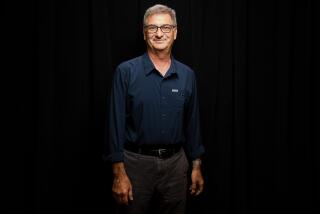Living on the Solar Side of the Street
Ted Baumgart uses his sunny back yard for something more than barbecuing or getting a tan. It’s his tribute, he says, to Mother Earth.
“Everything runs on solar,” boasts Baumgart, surveying his garden glade. It’s a storybook maze of waterfalls and pools in a bower of olive trees, ferns and Valencia oranges, outlined by a scalloped and turreted rock wall. “I’m working toward living off the (electrical power) grid right here.”
Baumgart is a free-lance commercial designer whose Hollywood work has included movie sets, prize-winning Rose Parade floats and television commercials. During the last three years, he has transformed the back yard of his family’s La Crescenta tract house. The resulting wonderland is his way of saying an ecological lifestyle can be fun.
“This is Ted’s baby and his dream,” says his wife, Cathryn Williams. “He had to wait for inspiration, for the right design to come along and it’s been a little confusing for the entire family. For a while we just had a big hole back there.”
Now, electricity generated by photovoltaic panels powers everything: the filtration system for his natural, river-rock swimming pool, which is purified by an ionization process; the stream and waterfall that recirculate into a fishpond; the miniature railroad that chugs and whistles its way through the gardens and stone portals, delivering food from an outdoor gingerbread-house kitchen.
Baumgart, whose next step is solar conversion and remodeling his two-bedroom house, threw a party recently to show off his yardwork for environmentally minded friends.
“He’s gone beyond functional to fantasy,” says Julia Russell, a friend and director of Eco-Home, a Los Feliz demonstration home. “It brings out the potential for fun and play and delight that’s possible in a ecological lifestyle.
That’s what Baumgart, 43, has dreamed about since he attended a 1975 energy conference at UCLA. Three days of solar hardware exhibits and alternative energy philosophy gave him an environmental focus, he says:
“I saw what was possible with alternative energy, and I felt certain that corporate America was not going to take the initiative. I felt that I needed to do it on an individual basis--that I needed to show people the possibilities.”
It was a logical goal for the ebullient Baumgart, who developed an environmental consciousness growing up in the Hollywood Hills and playing on coyote trails.
“I was raised in a self-searching family,” he says. “My grandmother lived in Ojai and we’d go there in the summer and fish and swim and horseback ride. She was into organic foods long before most people. We prided ourselves on taking a different view.”
Baumgart majored in environmental design at Pasadena’s Art Center College of Design. He contemplated a career steeped in ecological work, but the realities of earning a living dictated otherwise when he left school in 1972.
So Baumgart went to work in Hollywood, designing the sets, props and special effects that transport audiences into the world of fantasy: a colorful pair of 16-foot birds with 40-foot wing spans for a Rose Parade float; a super high-tech space-ship interior for the movie, “The Wizard”; a funky hotel rooftop with steam-hissing vents for rapper M.C. Hammer’s Taco Bell commercial.
He has channeled that same creativity and technical expertise into his home remodeling project.
“We bought this house in 1977 as a starter house and, the way things went, here we are still,” Baumgart says. “It’s just a little 1940s cracker box, but we’re going to build a solar home onto it.”
His model for the revamped house (which now has only a solar refrigerator as an ecological endorsement) includes solar water heating and electrical production, an open, sunlit central stairwell that lights the upstairs and downstairs, and a lot of “good old La Crescenta rock for holding the heat in winter and the coolness in summer.”
The yard took longer than anticipated, Baumgart says: “I started planning it six years ago and started working three years ago.”
The work, which included hauling 50 tons of river rock from the Tujunga Wash in his Volkswagen bus, was labor-intensive, he says, “and for a middle-class guy, a chunk out of our wallet. I employed two workers an entire year, just to build the stone wall. But a contractor friend of mine said he’d have to charge $150,000 to do it and I probably did it for somewhere in the 40s.”
“There have been many sleepless nights and much worry about why it wasn’t getting finished,” says Williams, a part-time physical therapist. “The kids (Heather, 11, and Dan, 7) would have liked it done sooner. But they like the pool now, and it has been an adventure seeing the yard change.”
Acknowledges the cheerful Baumgart: “It has tested the whole family. We joke that when the house gets finished, I will come home and find the locks changed.”
Paul Scott, a solar engineer who worked on the pool pump installation, praises Baumgart for providing “an exciting example of what’s possible in an environmental lifestyle. It’s like a little jungle oasis in the hills, and it’s all self-powered.”
That’s the point, says Baumgart, who has compiled a pamphlet for visitors that explains how the systems work and where the equipment is available.
While most people wouldn’t be interested in converting tons of rubble, rock and concrete into a garden wall, he admits, some aspects of solar conversion are relatively simple.
And anyone would like to imitate his back-yard utility bill.
Says Baumgart: “It’s zip.”
More to Read
Inside the business of entertainment
The Wide Shot brings you news, analysis and insights on everything from streaming wars to production — and what it all means for the future.
You may occasionally receive promotional content from the Los Angeles Times.










